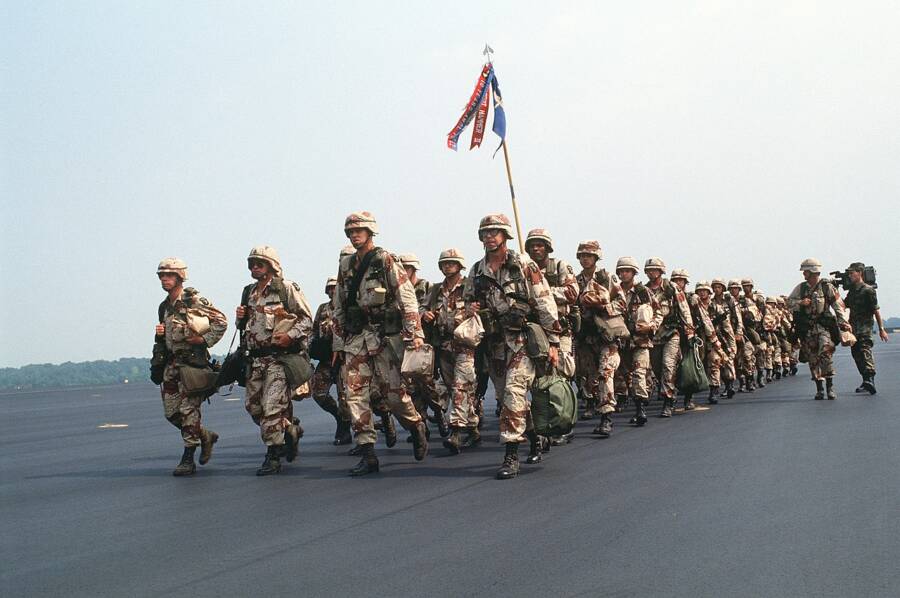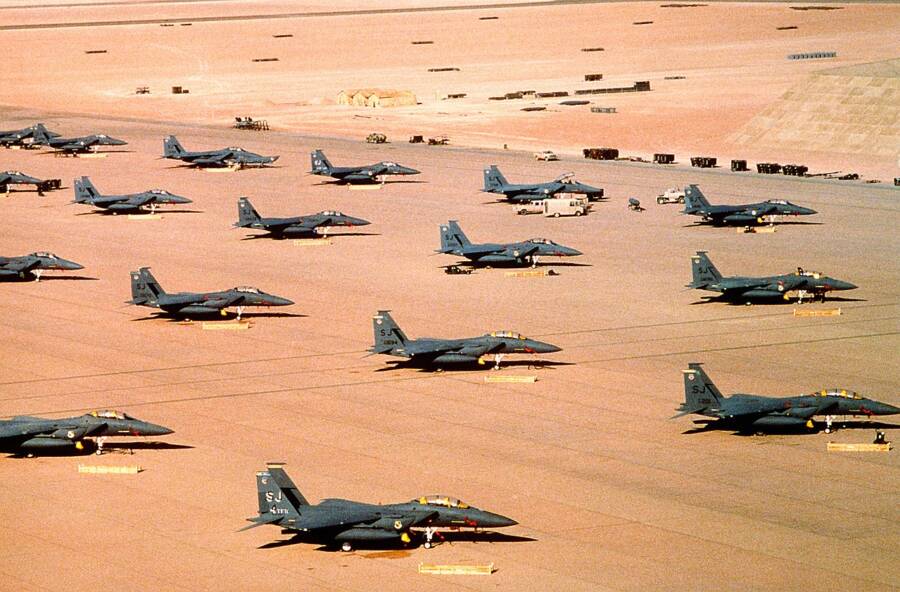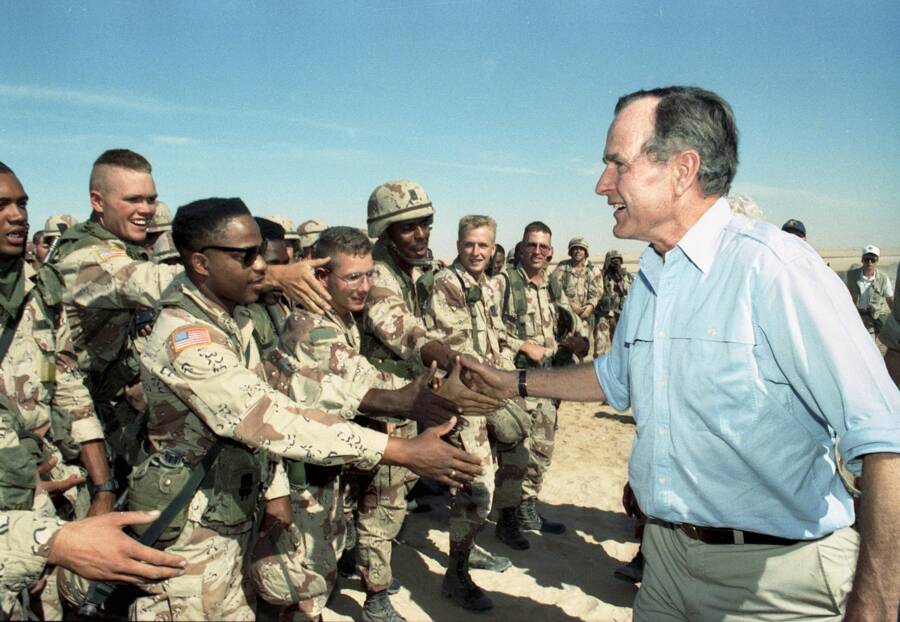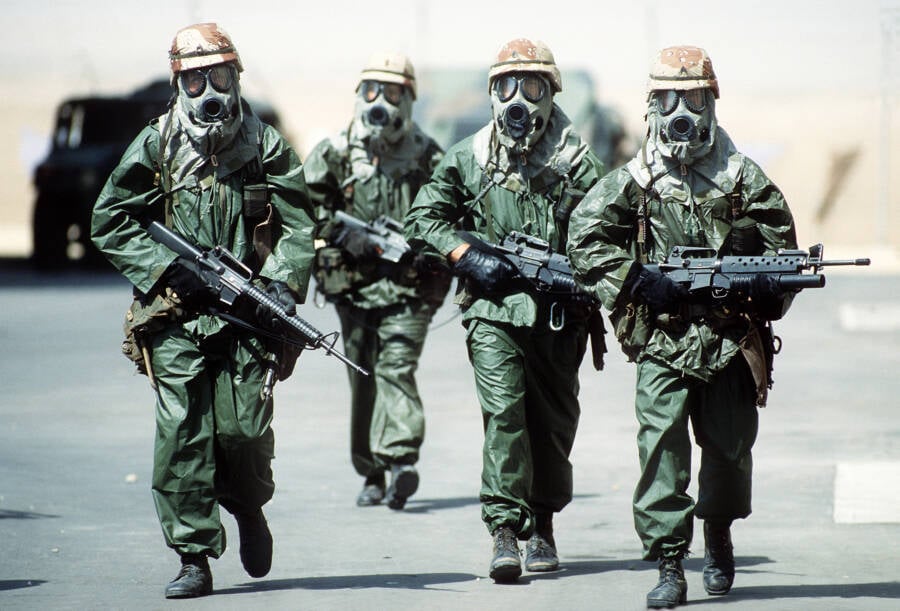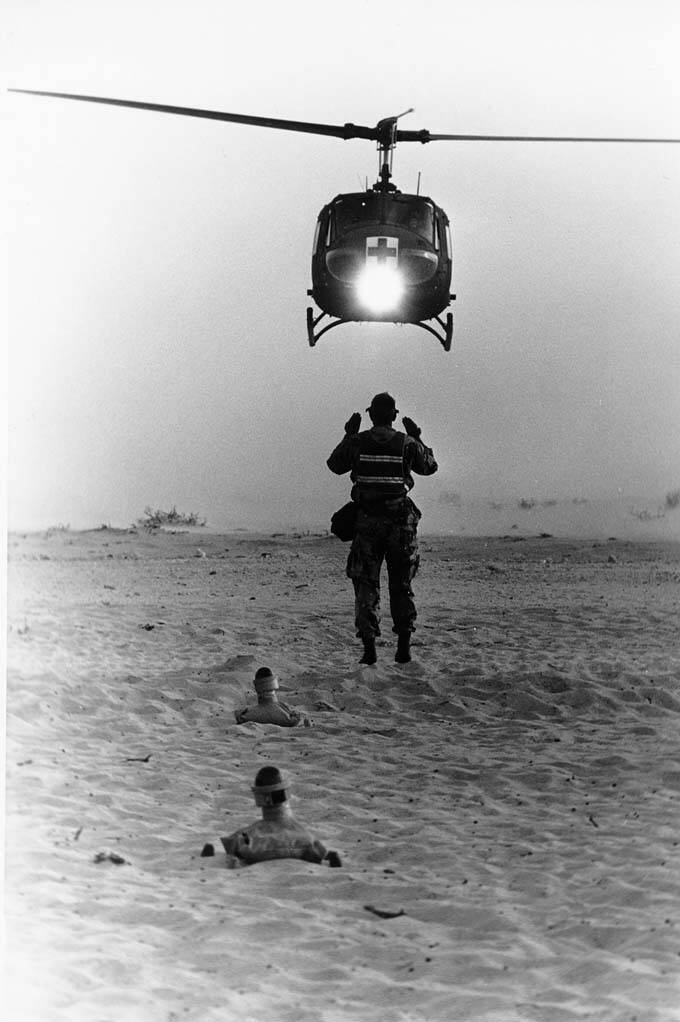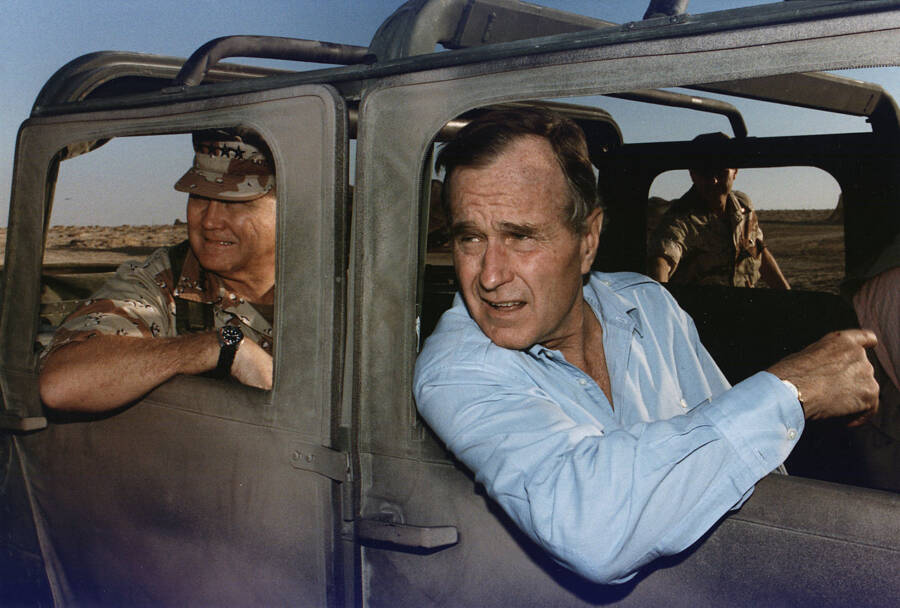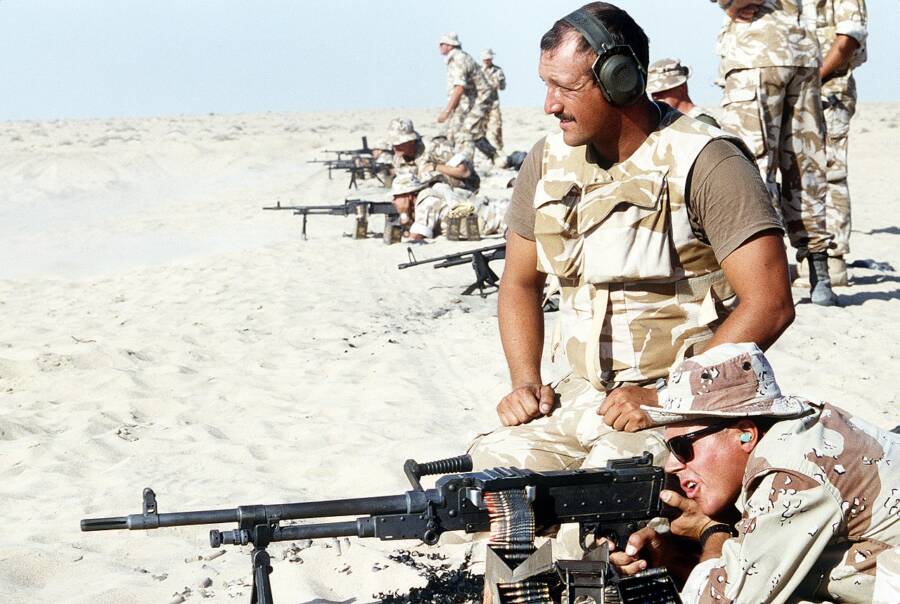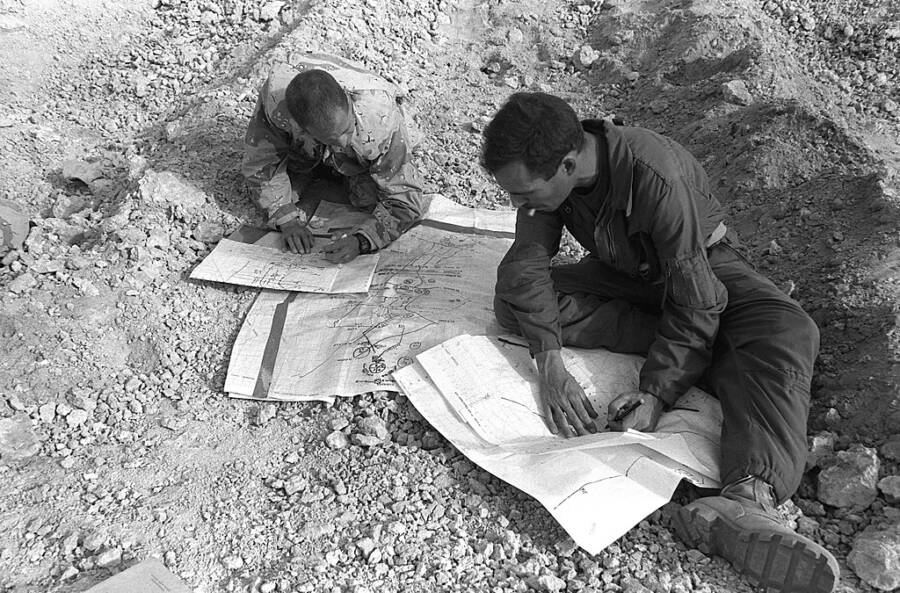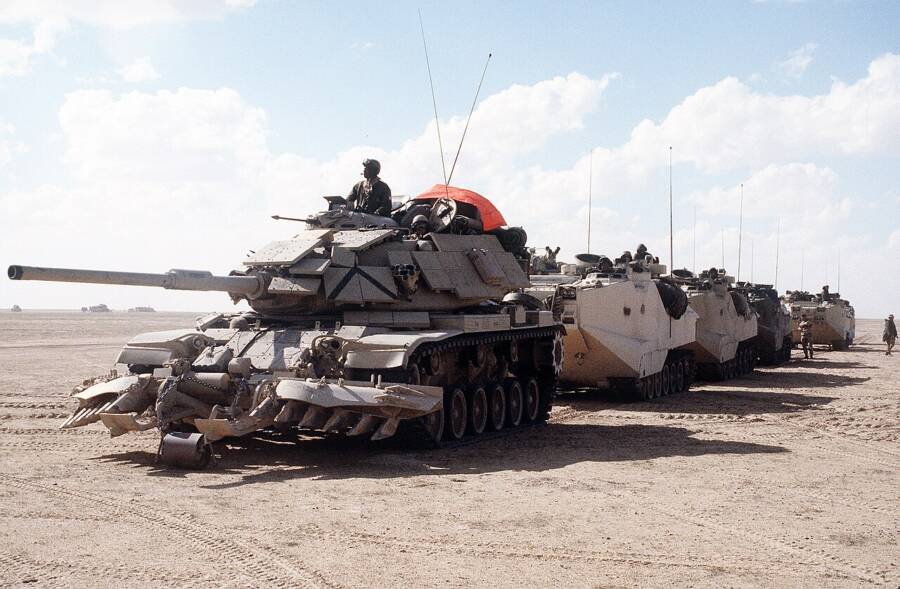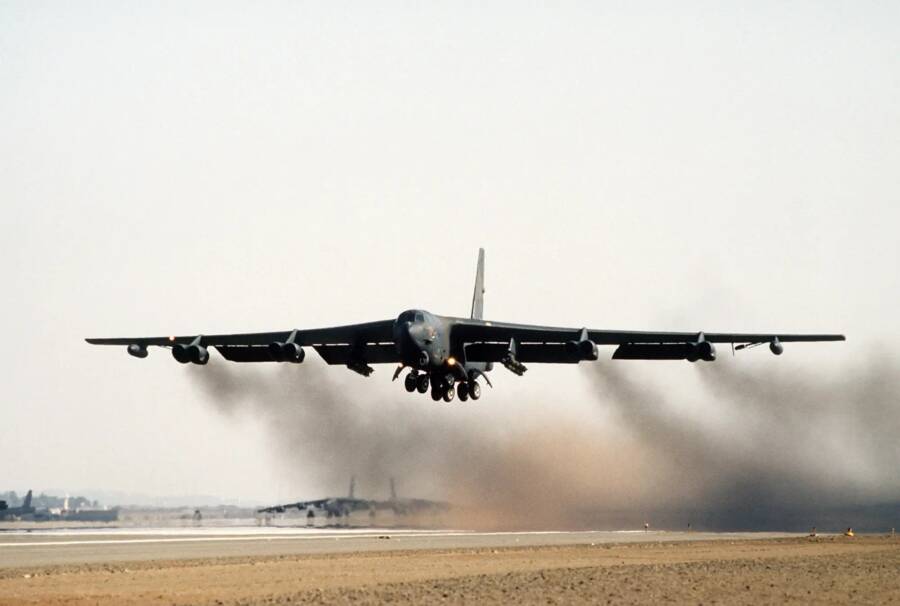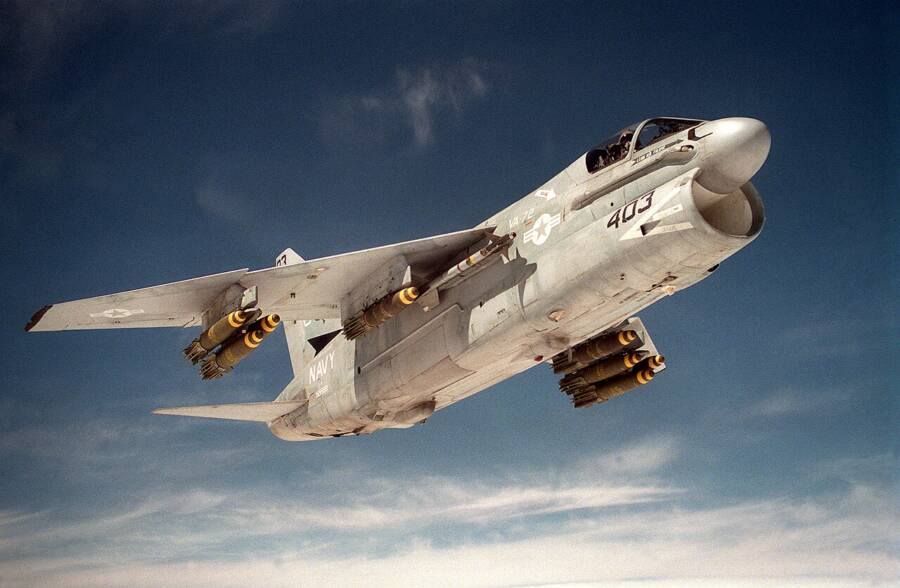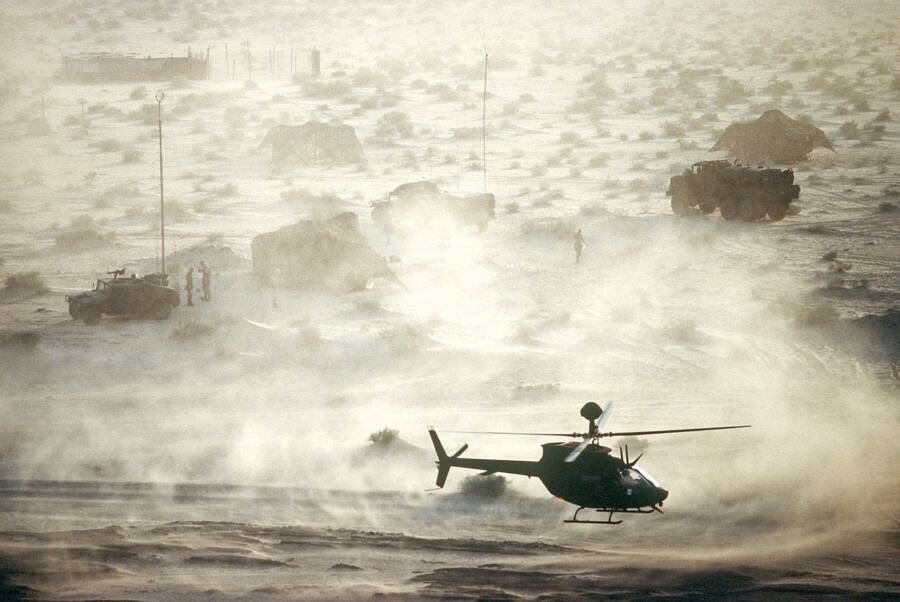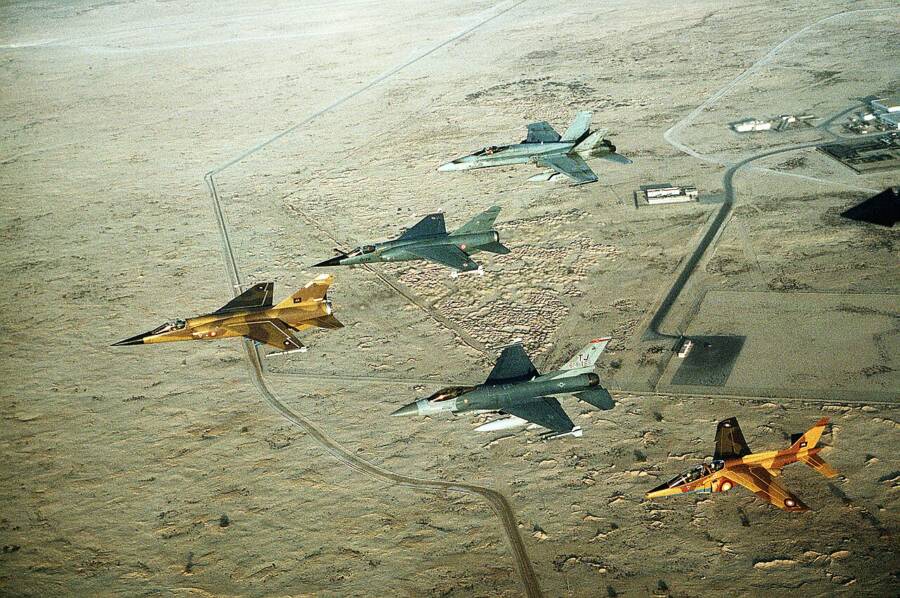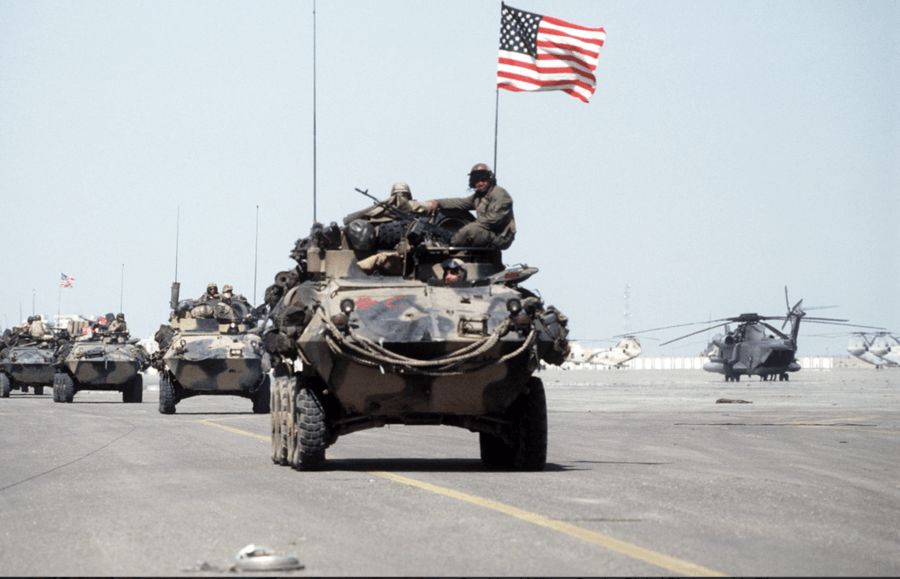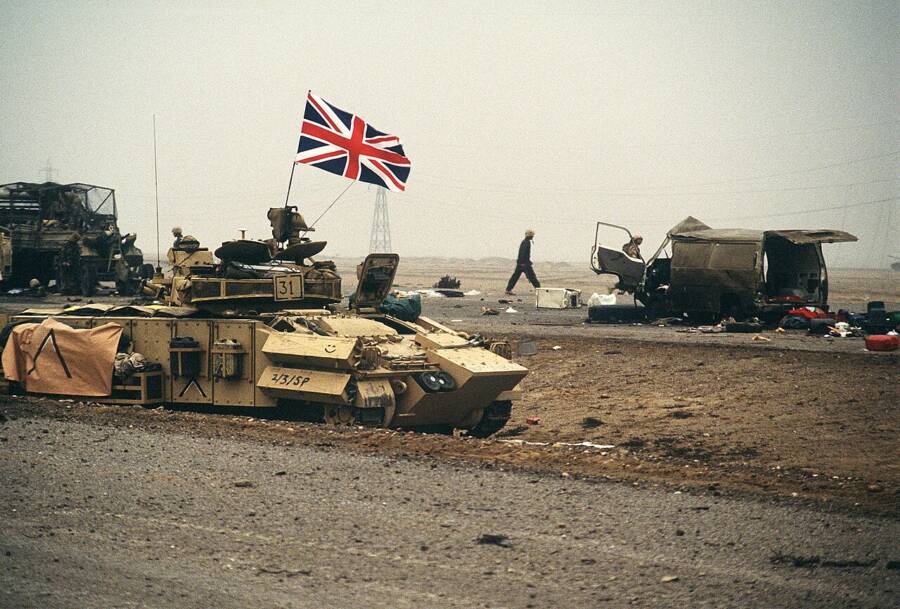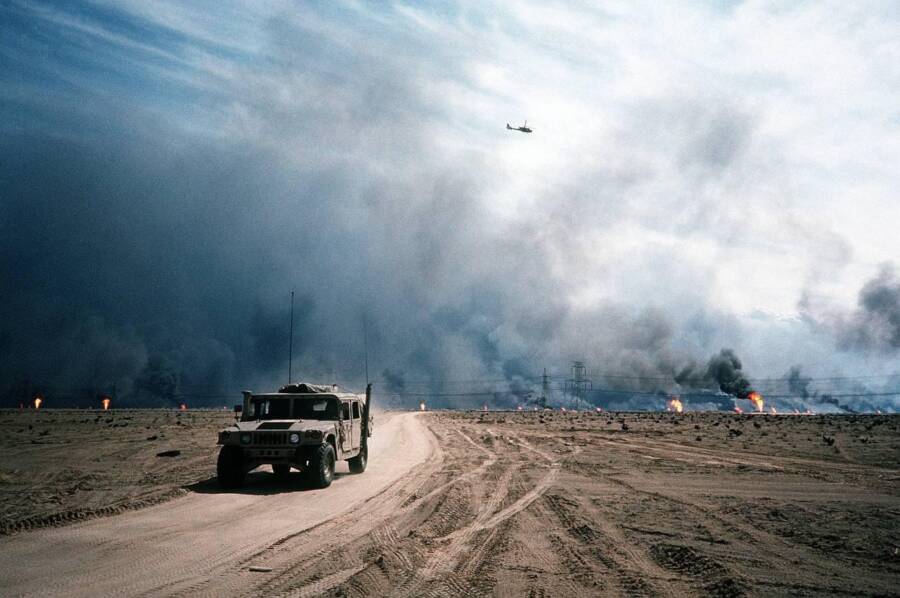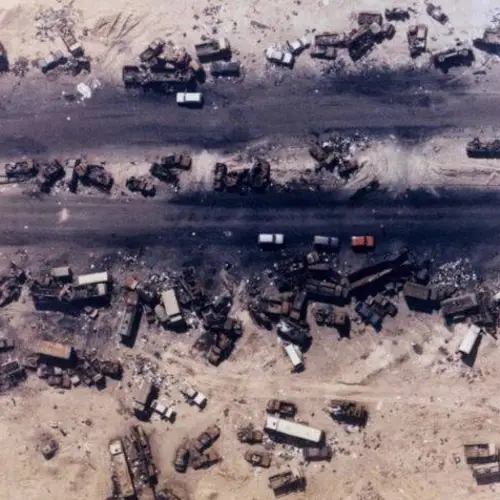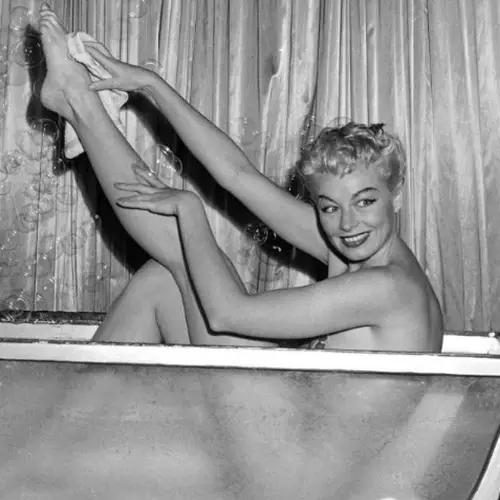Starting on August 2, 1990, a U.S.-led coalition fought to end the Iraqi occupation of Kuwait — and they succeeded on February 28, 1991.
On January 16, 1991, U.S. President George H.W. Bush made a promise to the nation. The United States was about to participate in a multinational military campaign to end the Iraqi occupation of Kuwait. But the Gulf War would not, Bush promised, "be another Vietnam."
When Saddam Hussein's forces invaded Kuwait on August 2, 1990, the international community had taken decisive action. The invasion was condemned by a majority of the Arab League and countries like the U.S., Britain, and the Soviet Union. That November, the United Nations gave Hussein a deadline to withdraw from Kuwait by January 15, 1991 — or else.
In the following months, hundreds of thousands of troops had arrived in the Middle East. The majority of the soldiers were Americans, but the coalition force also included troops from countries like Britain, France, Egypt, and Saudi Arabia. And when the January 15th deadline came and went, the coalition prepared to launch Operation Desert Storm to liberate Kuwait.
By February 28, 1991, the operation had ended. The Gulf War was over. But it would have long-lasting implications for the Middle East.
"This Is No Time To Go Wobbly"
The Gulf War began on August 2, 1990, when Iraqi President Saddam Hussein invaded Kuwait. Iraq had emerged as a regional power after the Iran-Iraq War, but that conflict had also ended in a stalemate and left Iraq in deep debt. When Kuwait and Saudi Arabia refused to cancel these debts, Hussein accused Kuwait of siphoning Iraqi oil from the Rumaila oil field, which sat between the two countries, and claimed that both Kuwait and Saudi Arabia had lowered oil prices in order to appease Western nations.
Then, on August 2, 1990, Iraq invaded Kuwait, its neighbor.
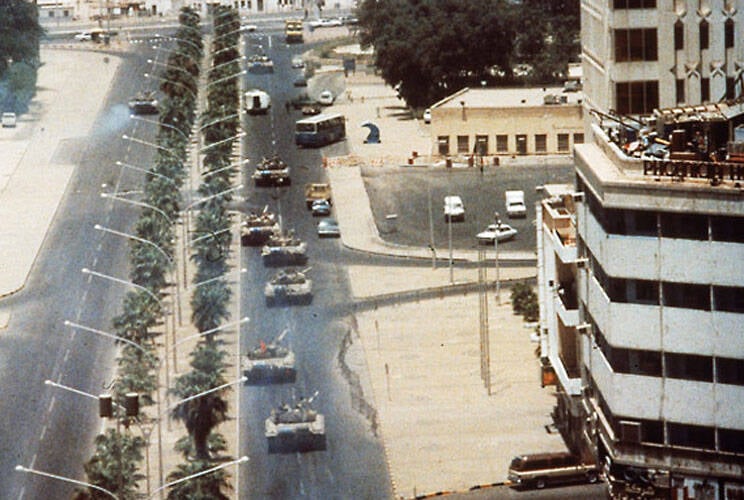
Public DomainIraqi tanks in Kuwait City in 1990.
The international response to the invasion was swift. Two-thirds of the Arab League nations condemned the invasion, as did many Western countries like the United States and Britain. On August 3rd, the United Nations called on Iraq to withdraw from Kuwait. On August 5th, Saudi Arabia agreed to station American troops on Saudi soil and U.S. President George H.W. Bush publicly declared: "This will not stand, this aggression of Kuwait."
Just three days later — the same day Iraq annexed Kuwait — the first wave of U.S. Air Force fighter planes began to arrive in Saudi Arabia. This marked the beginning of a military build-up known as Operation Desert Shield.
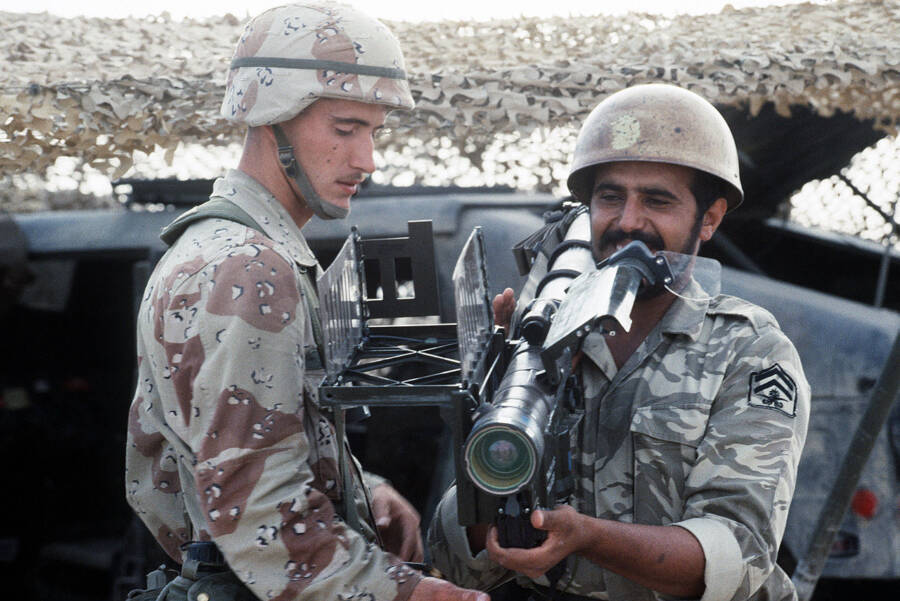
SPEC. SAMUEL HENRY/U.S. ArmyAn American soldier and a Saudi Arabian soldier take a close look at a FIM-92A Stinger portable anti-aircraft missile launcher during Operation Desert Shield.
"Remember, George," British Prime Minister Margaret Thatcher famously told President Bush amidst the crisis, "this is no time to go wobbly."
Over 35 nations came to join a U.S.-led coalition, which had the goal of protecting Saudi Arabia and pushing the Iraqis out of Kuwait. And on November 29th, the U.N. Security Council made it clear that the military build-up was not for show. They authorized "all necessary means" to remove Iraqi forces from Kuwait if Hussein didn't withdraw by January 15, 1991.
By mid-January, the coalition numbered 750,000 troops, including 540,000 American troops. But as the deadline approached — and the world anxiously watched — Iraq made no move to withdraw from Kuwait.
Operation Desert Storm: How The Persian Gulf War Unfolded
The next phase of the Gulf War began on January 17, 1991, once the deadline for Iraq to withdraw from Kuwait had passed. In the early morning in Baghdad, a huge aerial bombing campaign began as U.S. forces led an attack on Iraq's air defenses, communication networks, weapons plants, and oil refineries. This stage of the Gulf War was known as Operation Desert Storm.
"While the world waited, Saddam Hussein systematically raped, pillaged, and plundered a tiny nation, no threat to his own," Bush, who faced criticism for using force instead of economic sanctions, told the U.S. in a speech on January 16th. "[W]hile the world waited, while the world talked peace and withdrawal, Saddam Hussein dug in and moved massive forces into Kuwait."
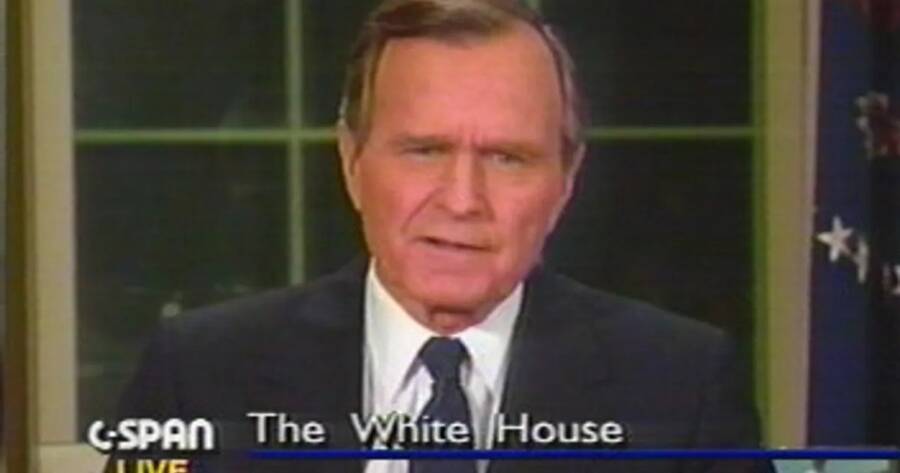
C-SPAN/Public DomainGeorge H.W. Bush announces that the Gulf War has begun in earnest after Iraq failed to withdraw from Kuwait.
Reassuring the nation that the U.S. would not get mired in a lengthy international conflict, the president continued: "I've told the American people before that this will not be another Vietnam, and I repeat this here tonight. Our troops will have the best possible support in the entire world, and they will not be asked to fight with one hand tied behind their back."
At this stage of the Gulf War, the coalition had three goals: to establish supremacy in the air, to destroy strategic targets, and to demoralize the Iraqi army. The coalition force relied on state-of-the-art military technology, which included satellite surveillance systems and precision-guided weapons.
About 10 days later, the coalition established air supremacy, having destroyed more than 100 Iraqi aircrafts (the coalition lost 39). The coalition then moved on to destroying strategic targets, like communication facilities and manufacturing plants — and it soon neutralized Iraq's navy.
On February 24th, the focus of the Gulf War shifted from an air war to a ground war with "Operation Desert Sabre." This lasted just 100 hours.
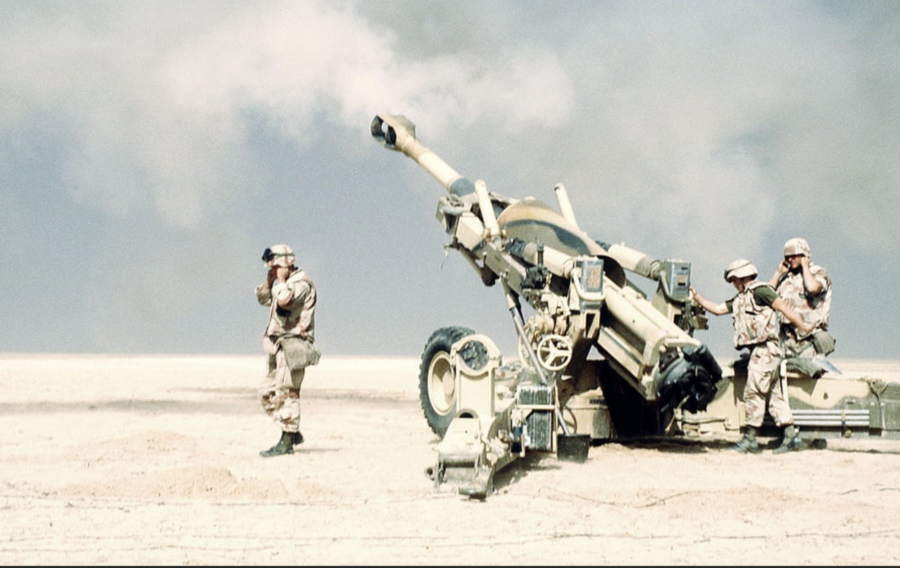
Public DomainU.S. Marines firing a M-198 155mm howitzer to support the ground offensive during Operation Desert Storm.
Coalition troops swept into Kuwait and southern Iraq from Saudi Arabia. They soundly defeated Iraqi forces — many of whom surrendered without even fighting — and liberated Kuwait by February 27th. And as Iraqi troops tried to flee from Kuwait along Highway 80, U.S. planes bombed the head and tail of the retreating convoy, trapping some 3,000 vehicles on the road.
For 10 hours, Highway 80 became "The Highway of Death" as U.S. aircraft bombed the trapped Iraqi soldiers, killing hundreds of them.
"I think we're past the point of just letting [Saddam Hussein] get in his tanks and drive them back into Iraq and say, 'I'm sorry,'" U.S. Air Force Lt. Col. George Patrick said. "I feel fairly punitive about it."

Peter Turnley/Corbis/VCG via Getty ImagesThe bodies of Iraqis who died on the "Highway of Death" while trying to leave Kuwait.
But there would be no further battles. Bush called for a ceasefire on February 28th, and the Gulf War ended that day.
"Kuwait," Bush said, "is liberated." He continued: "This war is now behind us. Ahead of us is the difficult task of securing a potentially historic peace."
But the conflict would have deep and long-lasting implications.
The Long-Lasting Impacts Of The Gulf War
The Gulf War had lasted less than a year, and the ground offensive itself had only lasted 100 hours. But the conflict had been devastating.

Lt. Col. Charles H. Cureton/U.S. Armed ForcesAn American vehicle destroyed by friendly fire during the Battle of Khafji.
Though brief, the Gulf War was not without loss of human life. Estimates of Iraqi fatalities range from about 10,000 to 50,000. Meanwhile, just 147 U.S. personnel and 47 British troops were killed in action. Only about 300 coalition troops total were killed during the conflict.
The conflict had impacted the region in other ways as well. As the Iraqi troops retreated from Kuwait, they set fire to some 700 Kuwaiti oil wells, which burned fiercely and seemingly without end. As The Guardian reported in 2021, smoke from the fires stretched nearly 800 miles. Approximately 11 million barrels of crude oil poured into the Persian Gulf — creating a nine-mile-long oil slick — and the desert was polluted with 300 oil lakes.
Though the fires were extinguished after several months, the damage left by the Iraqi forces was long-lasting, and negative effects from the environmental catastrophe can still be seen and felt in Kuwait today.

United States ArmyThe Kuwait oil well fires were one devastating consequence of the Gulf War. They blazed long after the war ended, and left behind significant environmental damage in Kuwait.
The Gulf War also had an impact on geopolitics. As the conflict drew to an end, President George H.W. Bush decided not to go after Saddam Hussein and allowed the Iraqi leader to remain in power. However, the U.N. did order Iraq to destroy all its weapons of mass destruction (WMD) after the war.
Overthrowing Hussein had never been Bush's intention, but Bush's choice not to do so remained controversial all the same. His decision was seen by some as necessary restraint, and by others as a misstep. And in 2003, after the 9/11 attacks, Bush's son, President George W. Bush, did opt to go after Saddam Hussein on the pretext that Iraq continued to hold WMDs.
Like his father, Bush built a "coalition of the willing" — but his decision to invade Iraq became unpopular abroad. And in the end, the intelligence that Iraq had a large arsenal of WMDs turned out to be largely faulty. Still, the United States was mired in the Iraq War from 2003 until 2011.
As such, the Gulf War had a huge impact on the entire world — one that we can still feel today. Though short, the conflict left deep and enduring scars.
After reading about the Gulf War, look through these stunning photos from within the trenches of World War I. Or, peruse these striking images from the Civil War, one of the first wars in history to be photographed.
